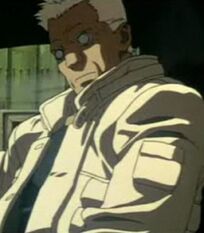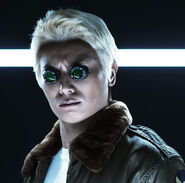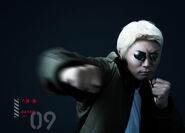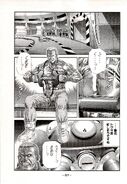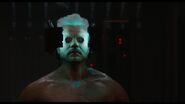Batou (original) (raw)
Batou Buttetsu (バトー ブッテツ, Batō Buttetsu) is a primary male character in the Ghost in the Shell franchise, the second best melee fighter in Section 9, and second in command behind Major Motoko Kusanagi. He is a former military ranger with a vast expertise in tactics and combat.
Ghost in the Shell manga[]
Batou originally appeared in the manga authored by Masamune Shirow, serialized in Kodansha's Young Magazine Pirate Edition, from 1989 to 1991. Shirow's characterization of Batou, and indeed the other members of Section 9, is notably more light-hearted than the characterization used in Mamoru Oshii's films of the same name. He frequently jokes with Motoko, Togusa, the Fuchikomas, and practically everyone else who crosses his path. His serious side becomes much more pronounced in an episode of the manga where Yano, a trainee of Batou's, is murdered by a cyber-criminal named Koil Krasnov. Batou loses his temper and impulsively calls up Section 9 Chief Aramaki, demanding an explanation for Yano's death, then storms off announcing, "That . . . Koil is dead meat!" Unlike S.A.C., where in a similar situation Batou spares the life of an ex-C.I.A. operative, Batou makes good on his threat and personally terminates Koil. His appearance and style of dress varies considerably over the series' run.
In Ghost in the Shell 2: Man/Machine Interface, Batou makes only a token cameo appearance, and is hardly recognizable. His head is shaved, and he is dressed in a simple black outfit. His sense of humor remains intact though. During a psychic monitoring of the virtual contact between Motoko; Aramaki; and another entity on the net, the psychic states, "Something of substance, something fruitful has passed between them"; to which Batou remarks, "A persimmon maybe?" This prompts Aramaki to issue an ultimatum: "If you can't be serious you can leave the room." He also asks to link with the psychic when she suffers a similar experience to Motoko's contact with the Puppet Master, but is vetoed.
Ghost in the Shell films[]
Batou in the Film Adaption
The Batou of Oshii's films is markedly different from the version in the television series. In the original film and its sequel, Batou is much more subdued, even to the point of brusqueness. In the first movie, Batou is depicted having a white crew-cut, similar to the manga, while in the second movie Batou has a short ponytail.
_Ghost in the Shell 2: Innocence_[]
Batou is the central character of Ghost in the Shell 2: Innocence and centers around his reaction to the disappearance of Major Motoko Kusanagi at the end of the first film. According to director Mamoru Oshii comments, the investigation is really secondary to the plot. The most notable about Batou's emotion in Innocence is his lack thereof; for the most part he expresses nothing whatsoever. In fact, the commentary on the Innocence DVD touches on the fact that it is Batou's lone companion, a Basset Hound named Gabriel, that express almost all of the emotion in the entire movie. When Batou is required to leave in order to continue his investigation, Gabriel is taken to Togusa's family to take care of, much to the delight of Togusa's young daughter and dread of his wife. Ishikawa, Batou's senior, chides him for keeping such a high-maintenance dog since he is a single man in a dangerous line of work. It is left up to the viewer to decide exactly what feelings Batou has or had for the Major, but there is rampant speculation that the movie is, at least in part, a love story. After he shot his own right arm as a result of brain-hacking, it was replaced with a new DNA-matched prosthetic with a two shot shotgun hidden inside. Batou is depicted as being tougher than in other Ghost In The Shell incarnations, as seen in his ability to shoot two live grenades and survive and his gigantic leap down the shaft of the Locus Solus factory ship. In both theatrical films, Batou carries a gun dubbed a "Jericho 942", based on the real Jericho 941 made by Israel Military Industries, but chambered for .50AE. In Innocence, he is also seen with a compact S&W pistol and a small semiautomatic shotgun. Other sources, including the Innocence prequel novel "After the Long Goodbye" note that Batou's S&W pistol is chambered for the .40 S&W cartridge.
_Ghost in the Shell: Stand Alone Complex_[]
Batou is a central character in the Stand Alone Complex television series. In contrast to the film version, this incarnation's personality and demeanor are more like that of the manga version. He is an outgoing joker, but with a quick temper. Being emotional and not always as calm as the Major, Batou shows anger at injustice and cruelty, to the point of seeming downright hotheaded at times. He sometimes shows impatience with Section 9's rookies, such as Togusa, to the point of rudeness, and jokes with him constantly.
At times, he is also shown to be a voice of reason and concern for the Major, to the point that she admits she can confide in him. Both seasons of the anime, like the films, hint at some romantic tension between the two, particularly near the end of each Gig. This tension is touched upon, briefly, in Solid State Society, where Batou admits that he's been covering up the Major's appearances in cases prior to the Puppet Master case. The movie closes with Batou's arm around the Major, although it's doubtful that the gesture is foretelling of any relationship between the two.
Prior to joining section 9, Batou served in the Japanese Ground Self-Defense Force, in the elite Ranger unit. It was there that he was outfitted with his grey, goggle-like cybernetic eyes, standard equipment for Rangers. He and his compatriots were involved in World War IV and deployed to South America alongside Motoko Kusanagi, where they accidentally stumbled across an American Imperial Navy unit conducting a covert operation codenamed "Project Sunset", which consisted of soldiers earning the trust of communities and then carrying out war crimes, spreading terror and chaos in the enemy ranks.
Batou is the favorite of the Tachikomas, as he showers them with care and affection. He has even dubbed one his "personal" Tachikoma, refusing to operate any other on an assignment and treating it with "natural oil", both habits which culminate in problems. Later in the series, the Tachikomas' AI starts to develop rapidly, which is attributed to a mutation in a protein chip caused by Batou's special oil. He is also one of the only characters to treat the Tachikomas as individuals, as opposed to interchangeable units, and they begin to view themselves as such, further contributing to the development of their AI.
Gallery[]
Batou - Ghost in the Shell movie (2017)
Batou on a rooftop - Ghost in the Shell movie (2017)
Batou and Motoko - Ghost in the Shell movie (2017)
Batou and Motoko walking - Ghost in the Shell movie (2017)
Trivia[]
- Batou was the second member recruited by the Major to Section 9, preceded by Ishikawa and followed by Saito.
- Batou's limbs are all cybernetic prosthetics. Despite the fact that exercise provides him little benefit, Batou enjoys jogging and weightlifting as a hobby.
- It is unknown to what degree Batou's body has been cyberized. Evidence suggests that, at the very least, his head is natural. Full cyberization would have likely replaced his old-model cybernetic eyes. He is also depicted with differing hairstyles throughout the franchise, suggesting that his hair grows and can be cut. In the manga, after he makes a snide remark to the Major, she strikes Batou on the forehead with a coffee mug; as he staggers away, he contemplates if he should go full cyborg.
- In S.A.C., Batou is often seen driving a modified Lancia Stratos coupe, one of his most cherished possessions. Togusa uses Batou's love of the car as a comeback after being criticized for his use of a revolver instead of modern handgun. In Solid State Society, Batou is shown driving a Ford GT.
- Batou's standard sidearm is a FN Browning BDA9 customized to fire .45 ACP (called FN Hi-Power M7), not the 5.45 mm Seburo M5, the standard Section 9 sidearm. In episode 15 of season one, he is shown evaluating the "GLOCK 33 Advanced", a reference to the "GLOCK 26 Advanced" airsoft gun manufactured in Japan by Tokyo Marui. The Glock 33 does exist, chambered for .357 SIG, but not in the customized "advanced" form depicted.
- In episode 16 of season one, "Ag2O", He is shown to possess a photograph of his family, depicting he and his wife, who resembles the Major, with their child, who resembles Togusa's son. His surname is also "Buttetsu". However, the picture was fabricated and was a part of his cover story while he spied on Zaitsev.
- In episode 13 of 2nd GiG, his rank badge says he may have been a Sergeant in the Army Rangers. In the final episode of 2nd GIG, Batou confronts a group of Rangers from Public Security Section 4, all of whom have artificial eyes identical to his own.
- Batou's original incarnation in the manga is considerably more comical than his anime counterpart. His eyes, though prosthetic, often bulge comically when he is alarmed. After Major Kusanagi is targeted by an assassin and ends up in the hospital, Batou becomes paranoid and suspects that a bomb has been planted in his car. He proceeds to dismantle the vehicle in the middle of the road outside the hospital, leading him to have an amusing argument with an ambulance driver.
- According to the comical Tachikomatic Days segment in episode 21 of S.A.C. season one, Batou enjoys a beer after his bath and takes out his cybernetic eye balls before going to sleep. In the following episode, it is similarly joked that Ishikawa drinks a glass of milk after his bath and takes off his beard before going to sleep.
